Spatiotemporal Dynamics of Direct Carbon Emission and Policy Implication of Energy Transition for China’s Residential Consumption Sector by the Methods of Social Network Analysis and Geographically Weighted Regression
Abstract
:1. Introduction
2. Materials and Methods
2.1. Data Description
2.2. Calculation of Direct RCEs
2.3. Spatial Association Network Construction of Direct RCEs
2.4. Network Characteristics
2.4.1. Overall Network Characteristics
2.4.2. Individual Network Characteristics
2.5. Spatial Clustering Analysis
2.6. Geographically Weighted Regression Model
3. Results
3.1. Amount and Structure of Direct RCEs
3.2. Characteristics of Spatial Association Network
3.2.1. Overall Network Characteristics
3.2.2. Individual Network Characteristics
3.3. Spatial Clustering Analysis
3.4. Driving Factors’ Analysis
4. Discussion
5. Conclusions and Suggestions
5.1. Conclusions
5.2. Suggestions
Author Contributions
Funding
Institutional Review Board Statement
Informed Consent Statement
Data Availability Statement
Acknowledgments
Conflicts of Interest
Appendix A
| Energy Type | Emission Coefficient (t-CO2/t) | Standard Coal Coefficient (kg ce/kg) |
|---|---|---|
| Raw coal | 1.977 | 0.7143 |
| Washed coal | 2.488 | 0.9000 |
| Other washed coal | 0.795 | 0.2857 |
| Briquettes | 1.717 | 0.6000 |
| Coke | 3.019 | 0.9714 |
| Coke oven gases | 7.421 a | 0.6143 b |
| Other gases | 7.421 a | 0.3570 b |
| Natural gas | 21.84 a | 1.3300 b |
| Liquefied natural gas | 2.836 | 1.7572 |
| Crude oil | 3.102 | 1.4286 |
| Gasoline | 3.185 | 1.4714 |
| Kerosene | 3.153 | 1.4714 |
| Diesel | 3.185 | 1.4571 |
| Lubricants | 2.948 | 1.4143 |
| Fuel oil | 3.126 | 1.4286 |
| Liquefied petroleum gas | 2.983 | 1.7143 |
| Other petroleum products | 2.948 | 1.2000 |
| Province | Emission Coefficient (kg/kw·h) | Grid Affiliation | Region | Emission Coefficient (kg/kw·h) | Grid Affiliation |
|---|---|---|---|---|---|
| Beijing | 0.8292 | NCPG | Tianjin | 0.8733 | NCPG |
| Shanxi | 0.8798 | NCPG | Inner Mongolia | 0.8503 | NCPG/NECPG |
| Jilin | 0.6787 | NECPG | Heilongjiang | 0.8158 | NECPG |
| Jiangsu | 0.7356 | ECPG | Zhejiang | 0.6822 | ECPG |
| Fujian | 0.5439 | ECPG | Jiangxi | 0.7635 | CCPG |
| Henan | 0.8444 | CCPG | Hubei | 0.3717 | CCPG |
| Guangdong | 0.6379 | SCPG | Guangxi | 0.4821 | SCPG |
| Chongqing | 0.6294 | CCPG | Sichuan | 0.2891 | CCPG |
| Yunnan | 0.4150 | SCPG | Shaanxi | 0.8696 | NWPG |
| Qinghai | 0.2263 | NWPG | Ningxia | 0.8184 | NWPG |
| Hebei | 0.9148 | NCPG | Hunan | 0.5523 | CCPG |
| Liaoning | 0.8357 | NCPG | Hainan | 0.6463 | SCPG |
| Shanghai | 0.7934 | ECPG | Guizhou | 0.6556 | SCPG |
| Anhui | 0.7913 | ECPG | Gansu | 0.6124 | NWPG |
| Shandong | 0.9236 | NCPG | Xinjiang | 0.7636 | NWPG |
| Province | Degree Centrality (%) | Betweenness Centrality | ||
|---|---|---|---|---|
| 2000 | 2019 | 2000 | 2019 | |
| Beijing | 93.10 | 79.31 | 25.22 | 12.42 |
| Tianjin | 58.62 | 72.41 | 8.67 | 10.05 |
| Hebei | 6.90 | 13.79 | 0.00 | 0.03 |
| Shanxi | 13.79 | 20.69 | 0.06 | 0.11 |
| Inner Mongolia | 10.34 | 13.79 | 0.04 | 0.06 |
| Liaoning | 10.34 | 13.79 | 0.04 | 0.06 |
| Jilin | 13.79 | 17.24 | 0.06 | 0.12 |
| Heilongjiang | 17.24 | 17.24 | 0.14 | 0.12 |
| Shanghai | 89.66 | 89.66 | 20.04 | 14.98 |
| Jiangsu | 68.97 | 82.76 | 8.38 | 12.56 |
| Zhejiang | 58.62 | 62.07 | 5.82 | 5.00 |
| Anhui | 20.69 | 24.14 | 0.16 | 0.27 |
| Fujian | 27.59 | 44.83 | 0.45 | 2.09 |
| Jiangxi | 20.69 | 24.14 | 0.16 | 0.27 |
| Shandong | 17.24 | 20.69 | 0.07 | 0.26 |
| Henan | 24.14 | 27.59 | 0.42 | 0.39 |
| Hubei | 17.24 | 48.28 | 0.09 | 1.71 |
| Hunan | 20.69 | 34.48 | 0.16 | 0.51 |
| Guangdong | 51.72 | 44.83 | 3.55 | 2.09 |
| Guangxi | 24.14 | 37.93 | 0.22 | 0.63 |
| Hainan | 20.69 | 27.59 | 0.09 | 0.34 |
| Chongqing | 24.14 | 37.93 | 0.33 | 0.60 |
| Sichuan | 20.69 | 31.03 | 0.21 | 0.51 |
| Guizhou | 24.14 | 31.03 | 0.22 | 0.51 |
| Yunnan | 20.69 | 31.03 | 0.21 | 0.51 |
| Shaanxi | 17.24 | 27.59 | 0.14 | 0.34 |
| Gansu | 31.03 | 41.38 | 1.09 | 1.31 |
| Qinghai | 20.69 | 31.03 | 0.21 | 0.44 |
| Ningxia | 17.24 | 24.14 | 0.06 | 0.12 |
| Xinjiang | 13.79 | 24.10 | 0.04 | 0.34 |
| Mean | 29.20 | 36.55 | 2.55 | 2.29 |
References
- Obama, B. The irreversible momentum of clean energy. Science 2017, 355, 126–129. [Google Scholar] [CrossRef] [PubMed] [Green Version]
- Jin, L.; Chang, Y.H.; Wang, M.; Zheng, X.Z.; Yang, J.X.; Gu, J. The dynamics of CO2 emissions, energy consumption, and economic development: Evidence from the top 28 greenhouse gas emitters. Environ. Sci. Pollut. Res. 2020, 29, 36565–36574. [Google Scholar] [CrossRef]
- IPCC. Climate Change 2014: IPCC Fifth Assessment Report; Cambridge University Press: Cambridge, UK, 2014; Available online: https://www.ipcc.ch/assessment-report/ar5/ (accessed on 9 December 2021).
- Meierrieks, D. Weather shocks, climate change and human health. World Dev. 2021, 138, 105228. [Google Scholar] [CrossRef]
- BP. Statistical Review of World Energy, 68th ed.; BP: London, UK, 2019; Available online: http://www.bp.com/statisticalreview (accessed on 9 December 2021).
- Anderson, T.R.; Hawkins, E.; Jones, P.D. CO2, the greenhouse effect and global warming: From the pioneering work of Arrhenius and Callendar to today’s Earth System Models. Endeavour 2016, 40, 178–187. [Google Scholar] [CrossRef] [PubMed] [Green Version]
- Gregg, J.S.; Andres, R.J.; Marland, G. China: Emissions pattern of the world leader in CO2 emissions from fossil fuel consumption and cement production. Geophys. Res. Lett. 2008, 35, L08806. [Google Scholar] [CrossRef]
- People. cn. Available online: http://www.people.com.cn/ (accessed on 9 December 2021).
- The Central People’s Government of the People’s Republic of China. Available online: http://www.gov.cn/ (accessed on 22 March 2022).
- Alam, M.J.; Begum, I.A.; Buysse, J.; Rahman, S.; Van Huylenbroeck, G. Dynamic modeling of causal relationship between energy consumption, CO2 emissions and economic growth in India. Renew. Sust. Energ. Rev. 2011, 15, 3243–3251. [Google Scholar] [CrossRef]
- Alfredsson, E.C. “Green” consumption—no solution for climate change. Energy 2004, 29, 513–524. [Google Scholar] [CrossRef]
- Li, K. Analysis of the Influencing Factors of Carbon Emissions of Domestic Energy Consumption of Urban and Rural Residents in China. Consumer Econ. 2013, 29, 73–76. Available online: https://kns.cnki.net/kcms/detail/detail.aspx?FileName=XFJY201302015&DbName=CJFQ2013 (accessed on 9 December 2021). (In Chinese).
- Bin, S.; Dowlatabadi, H. Consumer lifestyle approach to US energy use and the related CO2 emissions. Energy Policy 2005, 33, 197–208. [Google Scholar] [CrossRef]
- Druckman, A.; Jackson, T. The carbon footprint of UK households 1990–2004: A socio-economically disaggregated, quasi-multi-regional input-output model. Ecol. Econ. 2009, 68, 2066–2077. [Google Scholar] [CrossRef] [Green Version]
- Zhang, H.W.; Shi, X.P.; Wang, K.Y.; Xue, J.J.; Song, L.G.; Sun, Y.P. Intertemporal lifestyle changes and carbon emissions: Evidence from a China household survey. Energy Econ. 2020, 86, 104655. [Google Scholar] [CrossRef]
- Wiedenhofer, D.; Guan, D.B.; Liu, Z.; Meng, J.; Zhang, N.; Wei, Y.M. Unequal household carbon footprints in China. Nat. Clim. Change 2017, 7, 75. [Google Scholar] [CrossRef] [Green Version]
- Wu, Y.Z.; Shen, J.H.; Zhang, X.L.; Skitmore, M.; Lu, W.S. The impact of urbanization on carbon emissions in developing countries: A Chinese study based on the U-Kaya method. J. Clean. Prod. 2017, 163, S284–S298. [Google Scholar] [CrossRef]
- Hubacek, K.; Guan, D.B.; Barrett, J.; Wiedmann, T. Environmental implications of urbanization and lifestyle change in China: Ecological and Water Footprints. J. Clean Prod. 2009, 17, 1241–1248. [Google Scholar] [CrossRef]
- Tian, X.; Chang, M.; Lin, C.; Tanikawa, H. China’s carbon footprint: A regional perspective on the effect of transitions in consumption and production patterns. Appl. Energy 2014, 123, 19–28. [Google Scholar] [CrossRef]
- Fen, K.S.; Hubacek, K.; Guan, D.B. Lifestyles, technology and CO2 emissions in China: A regional comparative analysis. Ecol. Econ. 2009, 69, 145–154. [Google Scholar] [CrossRef]
- Wei, Y.M.; Liu, L.C.; Fan, Y.; Wu, G. The impact of lifestyle on energy use and CO2 emission: An empirical analysis of China’s residents. Energy Policy 2007, 35, 247–257. [Google Scholar] [CrossRef]
- Li, J.; Zhang, D.Y.; Su, B. The impact of social awareness and lifestyles on household carbon emissions in China. Ecol. Econ. 2019, 160, 145–155. [Google Scholar] [CrossRef]
- Ma, X.W.; Du, J.; Zhang, M.Y.; Ye, Y. Indirect carbon emissions from household consumption between China and the USA: Based on an input-output model. Nat. Hazards 2016, 84, S399–S410. [Google Scholar] [CrossRef]
- Zhou, J.; Shi, X.C.; Zhao, J.Y.; Su, L. On Regional Difference and Influential Factors of Carbon Emissions from Direct Living Energy Consumption of Chinese Residents. J. Saf. Environ. 2019, 19, 954–963. Available online: https://kns.cnki.net/kcms/detail/detail.aspx?FileName=AQHJ201903033&DbName=DKFX2019 (accessed on 9 December 2021). (In Chinese).
- Long, Y.; Huang, D.; Lei, T.Y.; Zhang, H.R.; Wang, D.P.; Yoshida, Y. Spatiotemporal variation and determinants of carbon emissions generated by household private car. Transp. Res. D Transp. Environ. 2020, 87, 102490. [Google Scholar] [CrossRef]
- Rong, P.J.; Zhang, Y.; Qin, Y.C.; Liu, G.J.; Liu, R.Z. Spatial differentiation of carbon emissions from residential energy consumption: A case study in Kaifeng, China. J. Environ. Manag. 2020, 271, 110895. [Google Scholar] [CrossRef] [PubMed]
- Kim, K.; Baek, Y.M.; Kim, N. Online news diffusion dynamics and public opinion formation: A case study of the controversy over judges’ personal opinion expression on SNS in Korea. Soc. Sci. J. 2015, 52, 205–216. [Google Scholar] [CrossRef]
- Wang, J.; Chen, W.; Yuan, F. Human mobility and evolution based on social network: An empirical analysis of Yangtze River Delta. Geogr. Res. 2014, 33, 385–400. Available online: https://kns.cnki.net/kcms/detail/detail.aspx?FileName=DLYJ201402017&DbName=CJFQ2014 (accessed on 6 December 2021). (In Chinese).
- Chen, C.; Liu, J.M.; Ma, H.T.; Wang, R.; Zhou, B.; Chen, N. Spatial network structure of inter-provincial farmer tourist flows in China. Acta Geogr. Sin. 2013, 68, 547–558. Available online: https://kns.cnki.net/kcms/detail/detail.aspx?FileName=DLXB201304013&DbName=CJFQ2013 (accessed on 6 December 2021). (In Chinese).
- Bu, Y.; Wang, E.D.; Bai, J.H.; Shi, Q.B. Spatial pattern and driving factors for interprovincial natural gas consumption in China: Based on SNA and LMDI. J. Clean. Prod. 2020, 263, 121392. [Google Scholar] [CrossRef]
- He, Y.Y.; Wei, Z.X.; Liu, G.Q.; Zhou, P. Spatial network analysis of carbon emissions from the electricity sector in China. J. Clean. Prod. 2020, 262, 121193. [Google Scholar] [CrossRef]
- Bai, C.Q.; Zhou, L.; Xia, M.L.; Feng, C. Analysis of the spatial association network structure of China’s transportation carbon emissions and its driving factors. J. Environ. Manag. 2019, 253, 109765. [Google Scholar] [CrossRef]
- Shen, W.R.; Liang, H.W.; Dong, L.; Ren, J.Z.; Wang, G.J. Synergistic CO2 reduction effects in Chinese urban agglomerations: Perspectives from social network analysis. Sci. Total Environ. 2021, 798, 149352. [Google Scholar] [CrossRef]
- Dong, H.J.; Geng, Y. A study on the Carbon Footprint of Residential Consumption in Beijing Based on Input-Output Analysis. Res. Sci. 2012, 34, 494–501. Available online: https://kns.cnki.net/kcms/detail/detail.aspx?FileName=ZRZY201203016&DbName=CJFQ2012 (accessed on 6 December 2021). (In Chinese).
- Li, Y.M.; Zhao, R.; Liu, T.S.; Zhao, J.F. Does urbanization lead to more direct and indirect household carbon dioxide emissions? Evidence from China during 1996–2012. J. Clean. Prod. 2015, 102, 103–114. [Google Scholar] [CrossRef]
- Mongelli, I.; Tassielli, G.; Notarnicola, B. Global warming agreements, international trade and energy/carbon embodiments: An input–output approach to the Italian case. Energy Policy 2006, 34, 88–100. [Google Scholar] [CrossRef]
- Li, H.; Zhao, Y.H.; Wang, S.; Liu, Y. Spatial-temporal characteristics and drivers of the regional residential CO2 emissions in China during 2000-2017. J. Clean. Prod. 2020, 276, 124116. [Google Scholar] [CrossRef]
- Wang, Y.; Yang, G.C.; Dong, Y.; Cheng, Y.; Shang, P.P. The scale, structure and influencing factors of total carbon emissions from households in 30 provinces of China-Based on the extended STIRPAT model. Energies 2018, 11, 1125. [Google Scholar] [CrossRef] [Green Version]
- Zang, X.L.; Zhao, T.; Wang, J.; Guo, F. The effects of urbanization and household-related factors on residential direct CO2 emissions in Shanxi, China from 1995 to 2014: A decomposition analysis. Atmos. Pollut. Res. 2017, 8, 297–309. [Google Scholar] [CrossRef]
- Fan, J.L.; Liao, H.; Liang, Q.M.; Tatano, H.; Liu, C.F.; Wei, Y.M. Residential carbon emission evolutions in urban-rural divide China: An end-use and behavior analysis. Appl. Energy 2013, 101, 323–332. [Google Scholar] [CrossRef]
- Zhou, X.Y.; Gu, A.L. Impacts of household living consumption on energy use and carbon emissions in China based on the input-output model. Adv. Clim. Chang. Res. 2020, 11, 118–130. [Google Scholar] [CrossRef]
- Yuan, B.L.; Ren, S.G.; Chen, X.H. The effects of urbanization, consumption ratio and consumption structure on residential indirect CO2 emissions in China: A regional comparative analysis. Appl. Energy 2015, 140, 94–106. [Google Scholar] [CrossRef]
- Cai, J.L.; Yin, H.; Varis, O. Impacts of industrial transition on water use intensity and energy-related carbon intensity in China: A spatio-temporal analysis during 2003-2012. Appl. Energy 2016, 183, 1112–1122. [Google Scholar] [CrossRef]
- Sheng, J.C.; Han, X.; Zhou, H. Spatially varying patterns of afforestation/reforestation and socio-economic factors in China: A geographically weighted regression approach. J. Clean. Prod. 2017, 153, 362–371. [Google Scholar] [CrossRef]
- Wang, Y.N.; Zhao, M.J.; Chen, W. Spatial effect of factors affecting household CO2 emissions at the provincial level in China: A geographically weighted regression model. Carbon Manag. 2018, 9, 187–200. [Google Scholar] [CrossRef]
- Wang, Y.N.; Luo, X.Y.; Chen, W.; Zhao, M.J.; Wang, B.W. Exploring the spatial effect of urbanization on multi-sectoral CO2 emissions in China. Atmos. Pollut. Res. 2019, 10, 1610–1620. [Google Scholar] [CrossRef]
- Zhao, G.P.; Yu, B.Y.; An, R.Y.; Wu, Y.; Zhao, Z.H. Energy system transformations and carbon emission mitigation for China to achieve global 2 degrees C climate target. J. Environ. Manag. 2021, 292, 112721. [Google Scholar] [CrossRef]
- Wang, Q.; Wang, S.S. Is energy transition promoting the decoupling economic growth from emission growth? Evidence from the 186 countries. J. Clean. Prod. 2020, 260, 120768. [Google Scholar] [CrossRef]
- Li, W.J.; Yu, X.Z.; Hu, N.; Huang, F.; Wang, J.; Peng, Q.N. Study on the relationship between fossil energy consumption and carbon emission in Sichuan province. Energy Rep. 2022, 8, 53–62. [Google Scholar] [CrossRef]
- Han, F.; Xie, R.; Lu, Y.; Fang, J.Y.; Liu, Y. The effects of urban agglomeration economies on carbon emissions: Evidence from Chinese cities. J. Clean. Prod. 2018, 172, 1096–1110. [Google Scholar] [CrossRef]
- Cheng, Y.Q.; Wang, Z.Y.; Zhang, S.Z.; Ye, X.Y.; Jiang, H.M. Spatial Econometric Analysis of Carbon Emission Intensity And Its Driving Factors from Energy Consumption in China. Acta Geogr. Sin. 2013, 68, 1418–1431. Available online: https://kns.cnki.net/kcms/detail/detail.aspx?FileName=DLXB201310012&DbName=CJFQ2013 (accessed on 6 December 2021). (In Chinese).
- Dong, F.; Li, J.Y.; Wang, Y.; Zhang, X.Y.; Zhang, S.N.; Zhang, S.Q. Drivers of the decoupling indicator between the economic growth and energy-related CO2 in China: A revisit from the perspectives of decomposition and spatiotemporal heterogeneity. Sci. Total Environ. 2019, 685, 631–658. [Google Scholar] [CrossRef]
- Lu, N.; Feng, S.Y.; Liu, Z.M.; Wang, W.D.; Lu, H.L.; Wang, M. The determinants of carbon emissions in the Chinese construction industry: A spatial analysis. Sustainability 2020, 12, 1428. [Google Scholar] [CrossRef] [Green Version]
- National Bureau of Statistics of China. China Energy Statistical Yearbook; China Statistics Press: Beijing, China, 2020; Available online: https://data.cnki.net/Yearbook/Single/N2021050066 (accessed on 6 December 2021).
- Kennedy, C.; Steinberger, J.; Gasson, B.; Hansen, Y.; Hillman, T.; Havranek, M.; Pataki, D.; Phdungsilp, A.; Ramaswami, A.; Mendez, G.V. Greenhouse gas emissions from global cities. Environ. Sci. Technol. 2009, 43, 7297–7302. [Google Scholar] [CrossRef]
- Jia, J.S.; Gong, Z.H.; Xie, D.M.; Chen, J.H.; Chen, C.D. Analysis of drivers and policy implications of carbon dioxide emissions of industrial energy consumption in an underdeveloped city: The case of Nanchang, China. J. Clean. Prod. 2018, 183, 843–857. [Google Scholar] [CrossRef]
- Wang, P.; Wu, W.S.; Zhu, B.Z.; Wei, Y.M. Examining the impact factors of energy-related CO2 emissions using the STIRPAT model in Guangdong Province, China. Appl. Energy 2013, 106, 65–71. [Google Scholar] [CrossRef]
- Zhang, M.; Mu, H.L.; Ning, Y.D. Decomposition of energy-related CO2 emission over 1991–2006 in China. Ecol. Econ. 2009, 68, 2122–2128. [Google Scholar] [CrossRef]
- Reinders, A.H.M.E.; Vringer, K.; Blok, K. The direct and indirect energy requirement of households in the European Union. Energy Policy 2003, 31, 139–153. [Google Scholar] [CrossRef]
- Shigetomi, Y.; Matsumoto, K.; Ogawa, Y.; Shiraki, H.; Yamamoto, Y.; Ochi, Y.; Ehara, T. Driving forces underlying sub-national carbon dioxide emissions within the household sector and implications for the Paris Agreement targets in Japan. Appl. Energy 2019, 228, 2321–2332. [Google Scholar] [CrossRef]
- Liu, H.J.; Liu, C.M.; Sun, Y.N. Spatial Correlation Network Structure of Energy Consumption and Its Effects in China. China Ind. Econ. 2015, 5, 83–95. Available online: https://kns.cnki.net/kcms/detail/detail.aspx?FileName=GGYY201505008&DbName=CJFQ2015 (accessed on 6 December 2021). (In Chinese).
- Liang, J.W.; Wen, S.H.; Fang, J.Z. The Spatial Economic Association of City Agglomeration on CAFTA Based on the Perspective of Social Network Analysis. Sci. Geogr. Sin. 2015, 35, 521–528. Available online: https://kns.cnki.net/kcms/detail/detail.aspx?FileName=DLKX201505002&DbName=CJFQ2015 (accessed on 6 December 2021). (In Chinese).
- Lv, K.J.; Feng, X.; Kelly, S.; Zhu, L.; Deng, M.Z. A study on embodied carbon transfer at the provincial level of China from a social network perspective. J. Clean. Prod. 2019, 225, 1089–1104. [Google Scholar] [CrossRef]
- Sun, Y.N.; Liu, H.J.; Liu, C.M.; Cui, R. Research on Spatial Association of Provinces Carbon Emissions and Its Effects in China. Shanghai J. Econ. 2016, 2, 82–92. Available online: https://kns.cnki.net/kcms/detail/detail.aspx?FileName=HSYJ201602010&DbName=CJFQ2016 (accessed on 6 December 2021). (In Chinese).
- Corradini, E.; Nocera, A.; Ursino, D.; Virgili, L. Investigating negative reviews and detecting negative influencers in Yelp through a multi-dimensional social network based model. Int. J. Inform. Manag. 2021, 60, 102377. [Google Scholar] [CrossRef]
- Cauteruccio, F.; Cinelli, L.; Giancarlo, F.; Claudio, S.; Giorgio, T.; Ursino, D.; Virgili, L. An approach to compute the scope of a social object in a multi-IoT scenario. Pervasive Mob. Comput. 2020, 67, 101223. [Google Scholar] [CrossRef]
- Ursino, D.; Virgili, L. An approach to evaluate trust and reputation of things in a Multi-IoTs scenario. Computing 2020, 102, 2257–2298. [Google Scholar] [CrossRef]
- Lo Giudice, P.; Mammone, N.; Morabito, F.C.; Pizzimenti, R.G.; Ursino, D.; Virgili, L. Leveraging network analysis to support experts in their analyses of subjects with MCI and AD. Med. Biol. Eng. Comput. 2019, 57, 1961–1983. [Google Scholar] [CrossRef] [PubMed]
- Ucer, S.; Kocak, Y.; Ozyer, T.; Alhajj, R. Social network analysis-based classifier (SNAc): A case study on time course gene expression data. Comput. Meth. Progr. Biomed. 2017, 150, 73–84. [Google Scholar] [CrossRef] [PubMed]
- Chen, S.H.; Wang, G.J.; Yan, G.F.; Xie, D.Q. Multi-dimensional fuzzy trust evaluation for mobile social networks based on dynamic community structures. Concurr. Comp-Pract. E. 2017, 29, e3901. [Google Scholar] [CrossRef]
- Zha, D.L.; Zhou, D.Q.; Zhou, P. Driving forces of residential CO2 emissions in urban and rural China: An index decomposition analysis. Energy Policy 2010, 38, 3377–3383. [Google Scholar] [CrossRef]
- Rong, Y.Y.; Jia, J.S.; Ju, M.; Chen, C.D.; Zhou, Y.M.; Zhong, Y.X. Mult-perspective analysis of household carbon dioxide emissions from direct energy consumption by the methods of logarithmic mean divisia index and sigma convergence in central China. Sustainability 2021, 13, 9285. [Google Scholar] [CrossRef]
- Fotheringham, A.S.; Brunsdon, C. Local forms of spatial analysis. Geogr. Anal. 1999, 31, 340–358. [Google Scholar] [CrossRef]
- Mainardi, S. Modelling spatial heterogeneity and anisotropy: Child anaemia, sanitation and basic infrastructure in sub-Saharan Africa. Int. J. Geogr. Inf. Sci. 2012, 26, 387–411. [Google Scholar] [CrossRef]
- Chen, X.H.; Zhao, Q.; Huang, F.; Qiu, R.Z.; Lin, Y.H.; Zhang, L.Y.; Hu, X.S. Understanding spatial variation in the driving pattern of carbon dioxide emissions from taxi sector in great eastern China: Evidence from an analysis of geographically weighted regression. Clean Technol. Envir. 2020, 22, 979–991. [Google Scholar] [CrossRef]
- Qin, H.T.; Huang, Q.H.; Zhang, Z.W.; Lu, Y.; Li, M.C.; Xu, L. Carbon dioxide emission driving factors analysis and policy implications of Chinese cities: Combining geographically weighted regression with two-step cluster. Sci. Total Environ. 2019, 684, 413–424. [Google Scholar] [CrossRef] [PubMed]
- Yang, X.H.; Jia, Z.; Yang, Z.M.; Yuan, X.Y. The effects of technological factors on carbon emissions from various sectors in China-A spatial perspective. J. Clean. Prod. 2021, 301, 126949. [Google Scholar] [CrossRef]



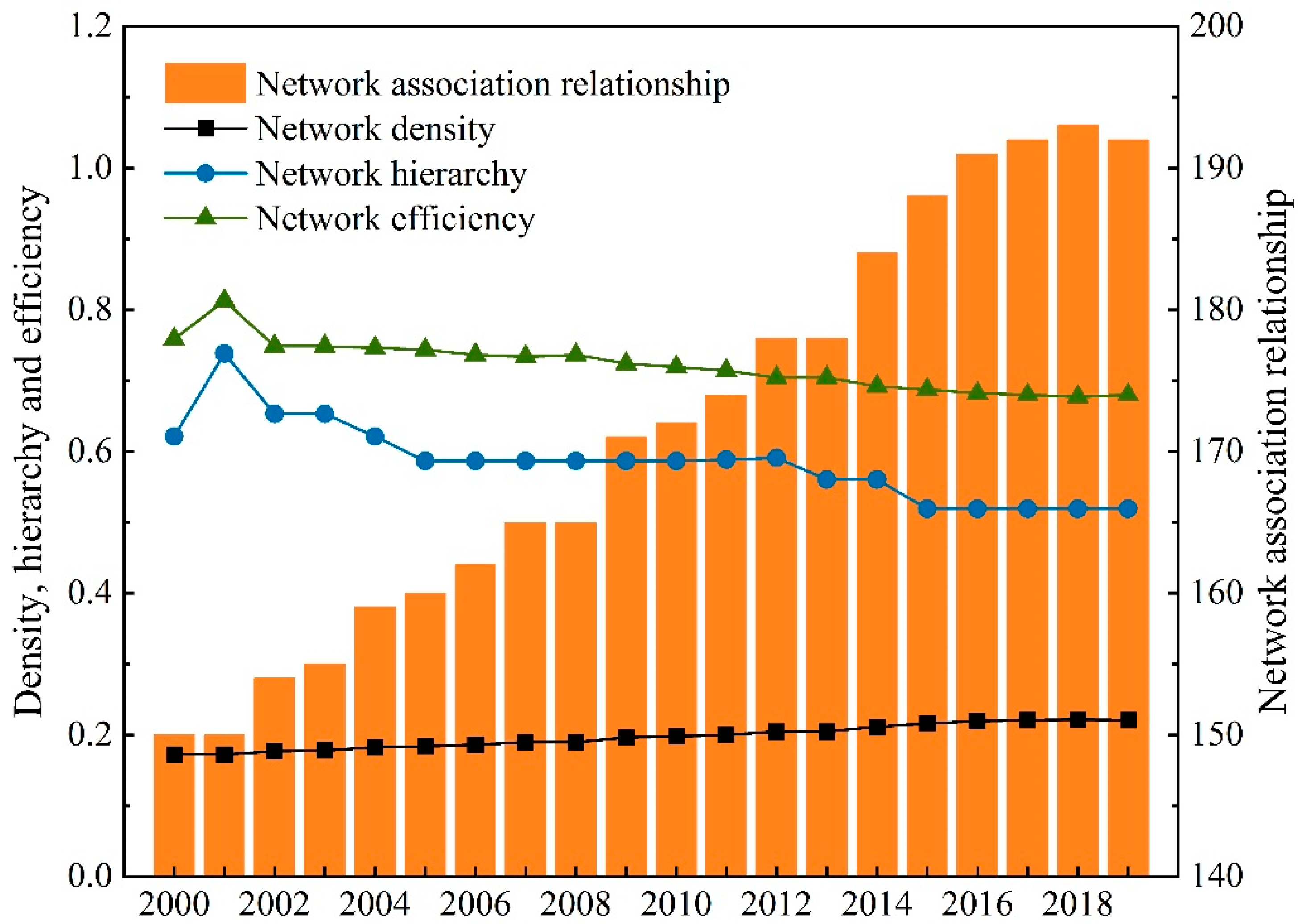
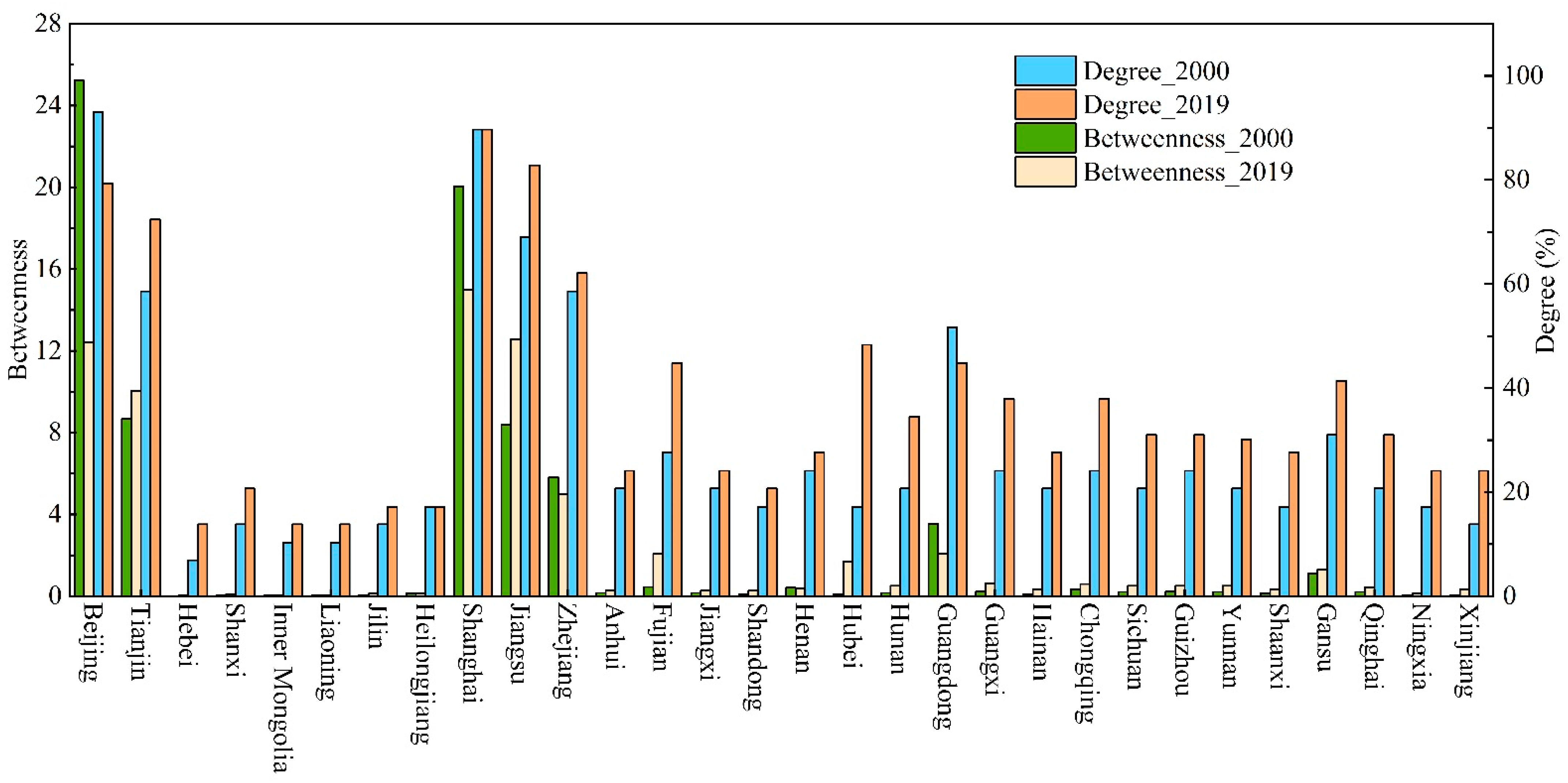
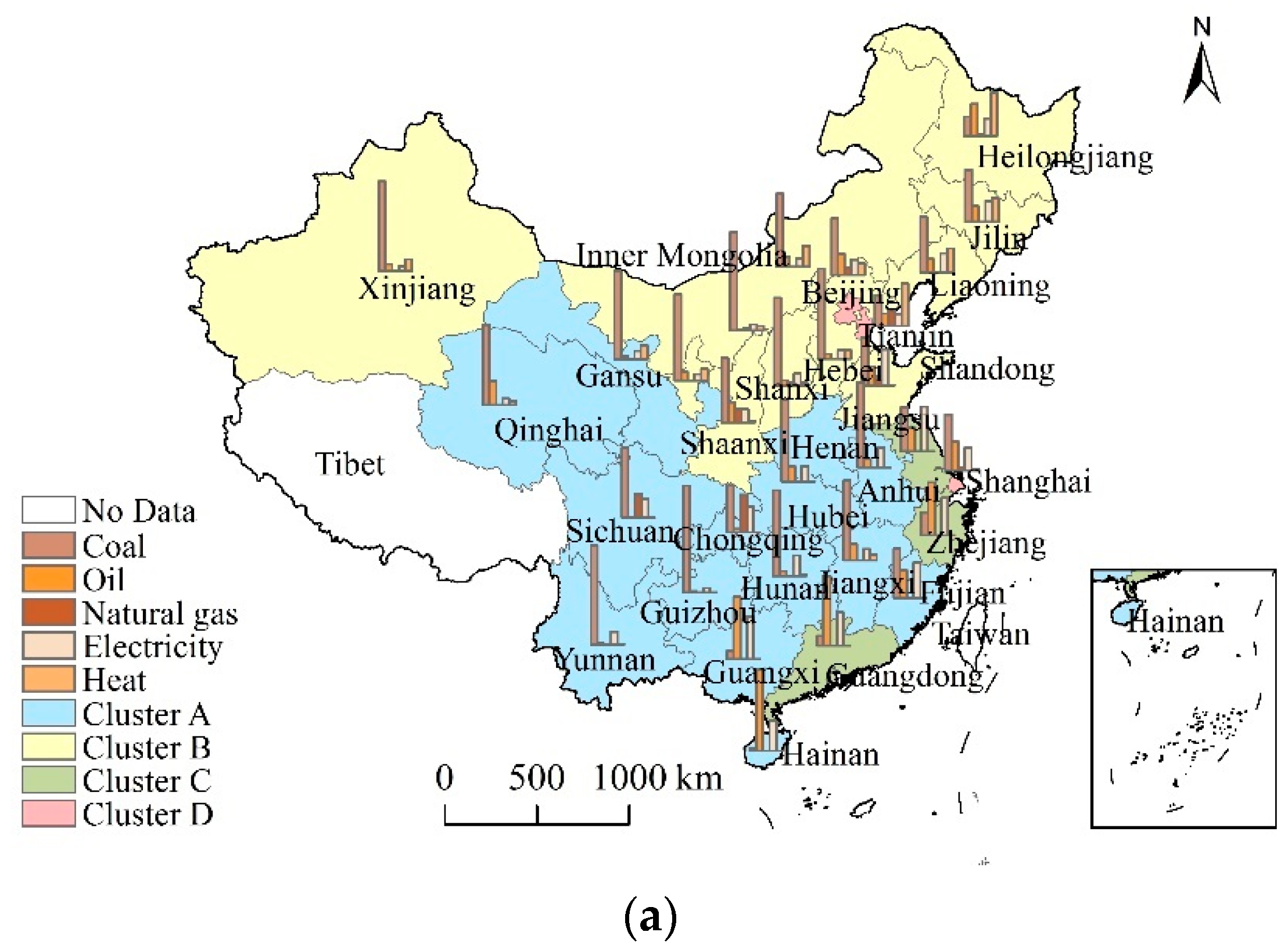
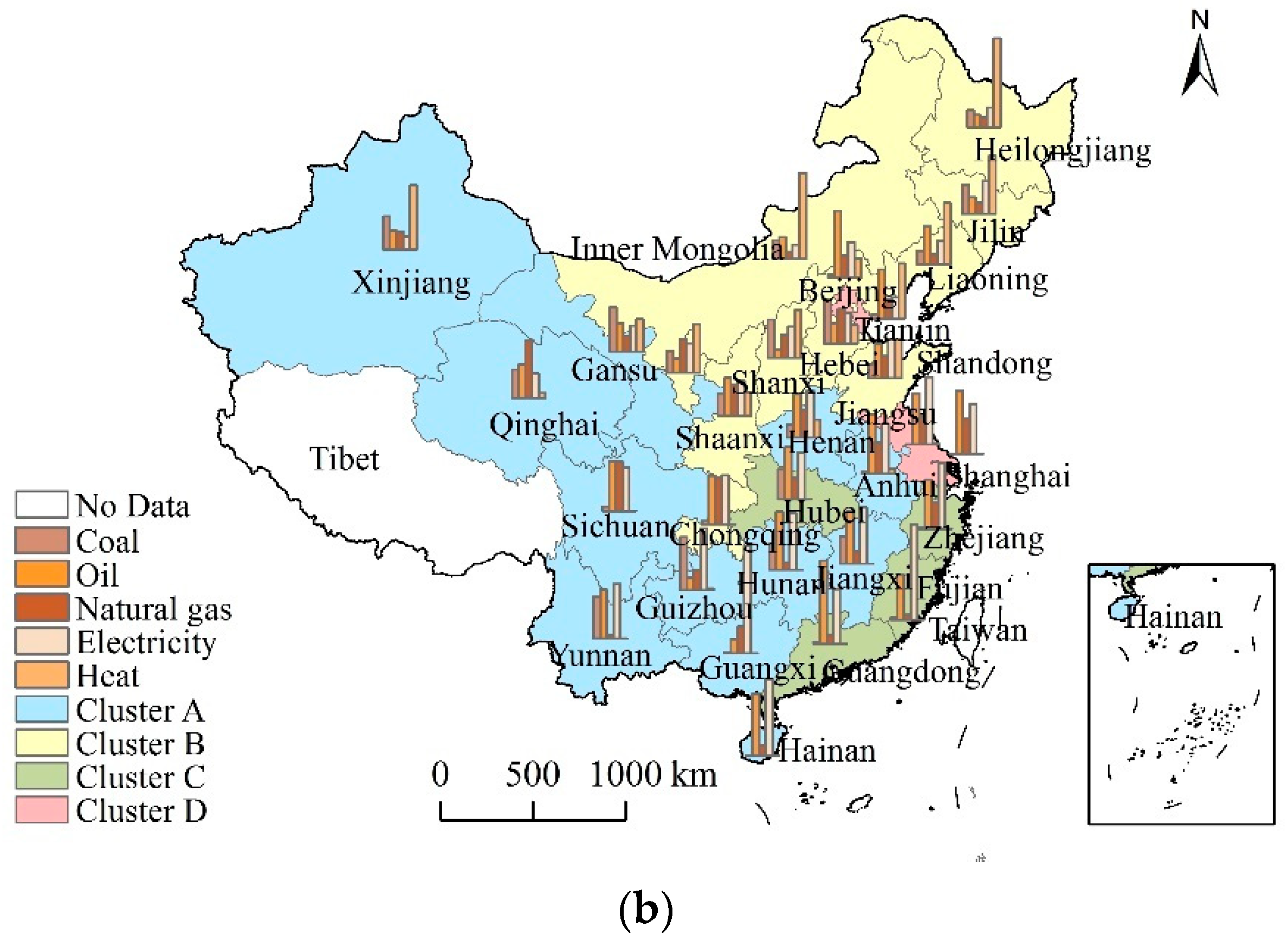

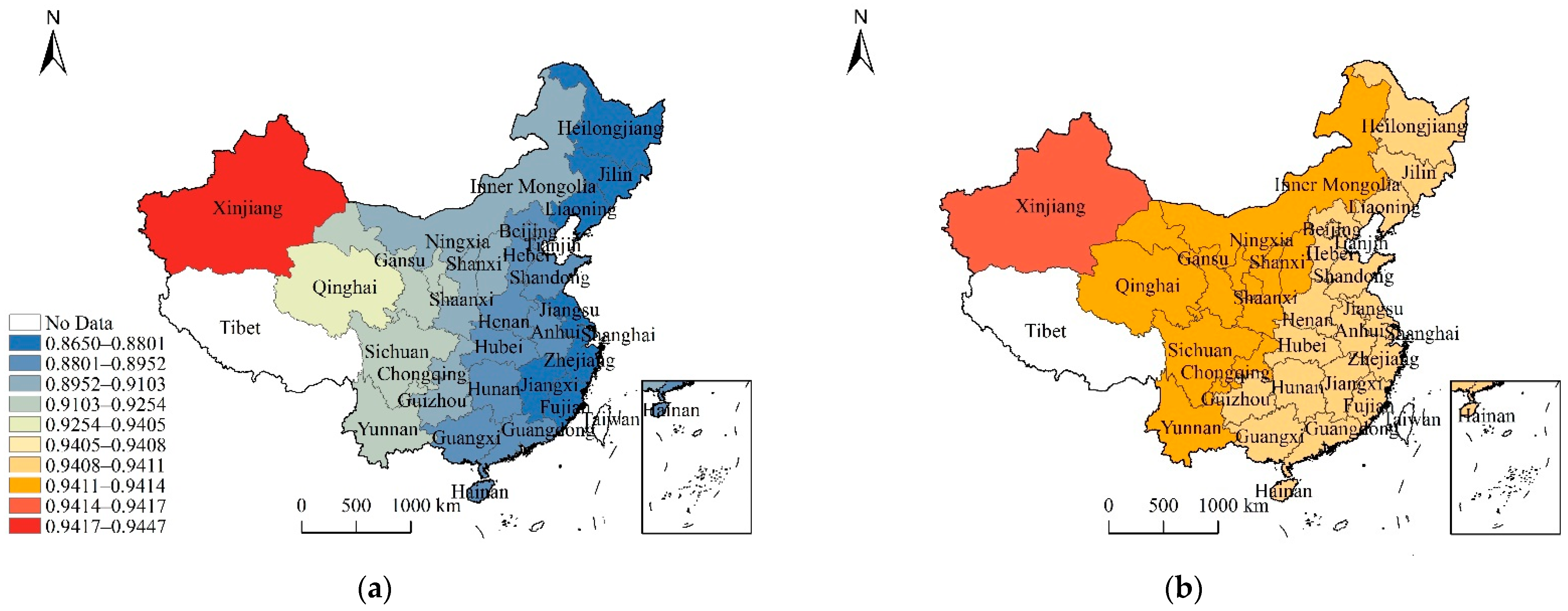


| Author(s) | Methods | Subject | Area and Period | Limitations and Innovation |
|---|---|---|---|---|
| Zhou et al. [24] | Spatial autocorrelation analysis; GWR model | RCEs in China | China 2003–2015 | The attribute rather than the relationship is considered when using spatial autocorrelation analysis to study spatial effects. |
| Long et al. [25] | Spatial autocorrelation analysis; panel data | CO2 emissions generated by private cars | Japan 1990–2016 | |
| Rong et al. [26] | Spatial autocorrelation analysis; GWR model | RCEs in Kaifeng | Kaifeng in China 2015–2016 | |
| He et al. [31] | SNA and the quadratic assignment procedure (QAP) | CO2 emissions from the electricity sector | China 2005–2016 | SNA is a method that quantifies relationships instead of the attribute of network actors and their connections, but it has rarely been applied in the study of RCEs. |
| Shen et al. [33] | Theil index and SNA | Synergistic emissions reduction effect of urban agglomerations | Yangtze River Delta, Chengdu–Chongqing urban agglomeration, and Guangdong–Hong Kong–Macao urban agglomeration in China 2010–2015 | |
| Bu et al. [30] | SNA and LMDI model | Interprovincial natural gas consumption | China 2005–2017 | |
| Bai et al. [32] | SNA and QAP | Transportation CO2 emissions | China 2005–2015 | |
| Wang et al. [38] | CLA model and STIRPAT model | Driving factors of RCEs | China 2006–2015 | These studies mainly used econometric methods that cannot investigate differences in the effects of drivers in spatial location. |
| Zang et al. [39] | LMDI model | Driving factors behind direct RCEs | Shanxi Province in China 1995–2014 | |
| Yuan et al. [42] | SDA model | Driving factors of indirect RCEs | China 2002–2007 | |
| Zhao et al. [47] | National energy technology model | Transition path of China’s energy system | China 2015–2050 | These studies just studied the national and regional CO2 emissions and energy transition, rarely conducted in the residential sector. |
| Wang et al. [48] | Tapio decoupling model and LMDI model | The effects of energy transition on the decoupling of economic growth from CO2 emission growth | 186 countries in the world 1990–2014 | |
| Li et al. [49] | Coal–gas transition balance theory | The relationship between fossil energy consumption transition and CO2 emissions | Sichuan Province in China 2005–2019 | |
| This paper | SNA and GWR model | RCEs and policy implications of energy transition | China 2000–2019 | This paper is the first to combine SNA and GWR to reveal the spatiotemporal dynamics characteristics and driving factors of direct RCEs, then gives some policy implications of energy transition. |
| Ratio of Internal Relationships | Ratio of Accepted Relationships | |
|---|---|---|
| ≈0 | >0 | |
| ≥ | Bidirectional spillover cluster | Net beneficiary cluster |
| ≤ | Net spillover cluster | Brokers cluster |
| Clusters | Receiving Relationships | Sending Relationships | Ratio of Expected Internal Relationships | Ratio of Actual Internal Relationships a | Cluster Type | |||
|---|---|---|---|---|---|---|---|---|
| Inside | Outside | Inside | Outside | |||||
| 2000 | A | 10 | 17 | 10 | 74 | 44.83% | 11.90% | Net Spillover |
| B | 0 | 6 | 0 | 39 | 31.03% | 0 | Net Spillover | |
| C | 0 | 47 | 0 | 16 | 6.90% | 0 | Brokers | |
| D | 2 | 68 | 2 | 9 | 6.90% | 18.18% | Net Beneficial | |
| 2019 | A | 3 | 32 | 3 | 92 | 37.93% | 3.16% | Net Spillover |
| B | 4 | 14 | 4 | 48 | 31.03% | 6.00% | Net Spillover | |
| C | 1 | 45 | 1 | 26 | 10.34% | 3.70% | Brokers | |
| D | 2 | 91 | 2 | 16 | 10.34% | 11.11% | Net Beneficial | |
| Clusters | Density Matrix | Image Matrix | |||||||
|---|---|---|---|---|---|---|---|---|---|
| A | B | C | D | A | B | C | D | ||
| 2000 | A | 0.055 | 0.014 | 0.905 | 0.81 | 0 | 0 | 1 | 1 |
| B | 0.021 | 0 | 0.233 | 0.967 | 0 | 0 | 0 | 1 | |
| C | 0.262 | 0 | 0 | 0.556 | 0 | 0 | 0 | 1 | |
| D | 0.071 | 0.133 | 0.222 | 0.333 | 0 | 0 | 1 | 1 | |
| 2019 | A | 0.023 | 0.058 | 0.813 | 0.958 | 0 | 0 | 1 | 1 |
| B | 0.050 | 0.044 | 0.100 | 0.95 | 0 | 0 | 0 | 1 | |
| C | 0.396 | 0.000 | 0.083 | 0.438 | 1 | 0 | 0 | 1 | |
| D | 0.146 | 0.175 | 0.125 | 0.167 | 0 | 0 | 0 | 0 | |
| VIF | GDP | AG | ECS | PEC | PCE | EDU |
|---|---|---|---|---|---|---|
| 2000 | 1.679 | 2.391 | 1.602 | 2.899 | 5.502 | 5.046 |
| 2019 | 1.670 | 1.168 | 1.716 | 1.778 | 5.634 | 5.673 |
| Overall Estimates | Average Regression Coefficients | |||||||||
|---|---|---|---|---|---|---|---|---|---|---|
| R2 | Adjust R2 | Bandwidth | AICC | GDP | AG | ECS | PEC | PCE | EDU | |
| 2000 | 0.762 | 0.666 | 2789137.739 | 472.742 | 0.893 | 0.247 | 0.121 | 0.794 | −0.702 | −0.134 |
| 2019 | 0.798 | 0.745 | 35816131.810 | 540.503 | 0.941 | 0.192 | 0.104 | 0.439 | −0.381 | −0.011 |
Publisher’s Note: MDPI stays neutral with regard to jurisdictional claims in published maps and institutional affiliations. |
© 2022 by the authors. Licensee MDPI, Basel, Switzerland. This article is an open access article distributed under the terms and conditions of the Creative Commons Attribution (CC BY) license (https://creativecommons.org/licenses/by/4.0/).
Share and Cite
Sun, Y.; Jia, J.; Ju, M.; Chen, C. Spatiotemporal Dynamics of Direct Carbon Emission and Policy Implication of Energy Transition for China’s Residential Consumption Sector by the Methods of Social Network Analysis and Geographically Weighted Regression. Land 2022, 11, 1039. https://doi.org/10.3390/land11071039
Sun Y, Jia J, Ju M, Chen C. Spatiotemporal Dynamics of Direct Carbon Emission and Policy Implication of Energy Transition for China’s Residential Consumption Sector by the Methods of Social Network Analysis and Geographically Weighted Regression. Land. 2022; 11(7):1039. https://doi.org/10.3390/land11071039
Chicago/Turabian StyleSun, Yuling, Junsong Jia, Min Ju, and Chundi Chen. 2022. "Spatiotemporal Dynamics of Direct Carbon Emission and Policy Implication of Energy Transition for China’s Residential Consumption Sector by the Methods of Social Network Analysis and Geographically Weighted Regression" Land 11, no. 7: 1039. https://doi.org/10.3390/land11071039
APA StyleSun, Y., Jia, J., Ju, M., & Chen, C. (2022). Spatiotemporal Dynamics of Direct Carbon Emission and Policy Implication of Energy Transition for China’s Residential Consumption Sector by the Methods of Social Network Analysis and Geographically Weighted Regression. Land, 11(7), 1039. https://doi.org/10.3390/land11071039






